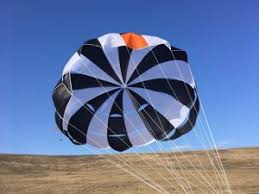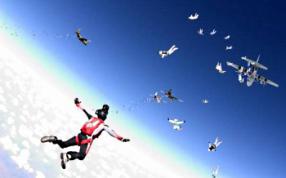How to make money on parachuting (part 2)
 In Soviet times, two categories of the population parachuted: the military and athletes. After the collapse of the USSR, funding for sports clubs that formed the reserve of the airborne forces gradually stopped. The Defense Assistance Society of Ukraine (OSOU), the successor of DOSAAF, could not help ASK, which were unprofitable. More or less stable work of dropzones was resumed only in 2000, when the Ukrainian middle class showed interest in skydiving. Wealthy audience pulled to extreme.
In Soviet times, two categories of the population parachuted: the military and athletes. After the collapse of the USSR, funding for sports clubs that formed the reserve of the airborne forces gradually stopped. The Defense Assistance Society of Ukraine (OSOU), the successor of DOSAAF, could not help ASK, which were unprofitable. More or less stable work of dropzones was resumed only in 2000, when the Ukrainian middle class showed interest in skydiving. Wealthy audience pulled to extreme.
However, the quality of the services offered by the clubs did not at all correspond to the increased demands of paratroopers. In the clubs that were formerly part of DOSAAF, jumps were carried out on round uncontrolled parachutes of Soviet production, according to Soviet training programs. Modern technology and training programs were not used. Worn out parachutes, which often developed their life, certainly added a thrill, but they did not guarantee safety. Therefore, first in neighboring Russia, and then in Ukraine, DZ began to appear, offering modern and safe training programs for skydiving.
In Ukraine, there are only three such remote sensing systems: two near Kiev and one near Dnepropetrovsk. But they can no longer always satisfy growing demand. For example, not only Kiev parachutists, but also skydivers from Lviv, Lugansk, Odessa come to the Borodyanka DZ (the PARA-SKUF Association, Kiev region), last year, according to Dmitry Karpekov, more than 14 thousand jumps. While for most former DOSAAF clubs, the norm is 2-3 thousand per season (usually from April to October, while the weather allows). For comparison: each of the leading Russian remote sensing centers (Stupino and Kolomna) performs 80 thousand jumps a year – this is approximately equal to the annual number of jumps in all flying clubs in Ukraine.
Profitability of successfully working Ukrainian drop zones is 10%. It is achieved through the use of new hopping equipment and modern training programs. This is what attracts customers who pay not only for jumping and equipment rental, but also for additional services.
It is possible to increase the profitability of this business by increasing the throughput of subsidiaries and offering a number of additional services. For example, in Europe and the USA, DZ have at least three aircraft, which ensures almost uninterrupted jumping of everyone. In addition, there are two or three tandem instructors, handlers, trainers in various parachute disciplines and video operators. There must be an insurance agent at the airport. You can’t jump without third-party liability insurance in Europe and America.
Additional service: classroom, mini-hotel, guarded parking, bar or cafe, parachute equipment store. The leading DZs, for example, the Spanish Empuriyabrava, American Deland and Arizona, work year-round, almost seven days a week. Despite significant regular costs for maintaining equipment and structures in good condition, drop zones remain a very profitable enterprise. According to Dmitry Karpekov, the aforementioned American DZs, where about 300 thousand jumps are made per year, operate with a profitability of 60%.
To create a European-class DZ, it is necessary to invest from $ 200 to $ 600 thousand, said Alexei Sharadkin, director of SkyWideSystems (SWS, production and maintenance of parachute equipment). And this is only in the case when DZ is created on the basis of an already existing flying club (as, for example, the PARA-SKUF Association was created. – For more details see the interview by Dmitry Karpekov on page 66). Then the main costs will be for the rental or purchase of an aircraft, acquisition of parachute equipment, and organization of infrastructure. If the investor intends to start from scratch, the amount increases two to three times – you will have to build a runway, office buildings, let down communications, etc.
In addition, you will have to pay for the issuance of various permits and approvals: from permission to organize parachute jumps and register the aircraft with the State Aviation Administration to obtain licenses and approve the time and altitude of flights.




